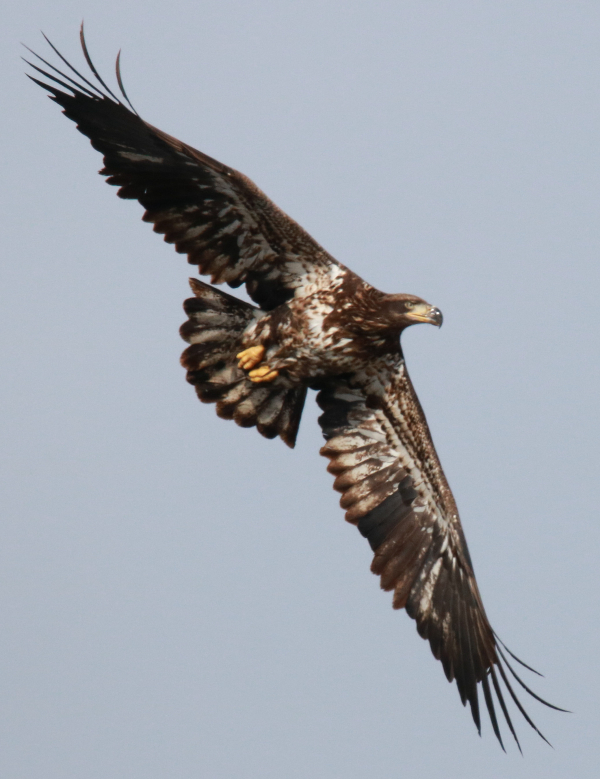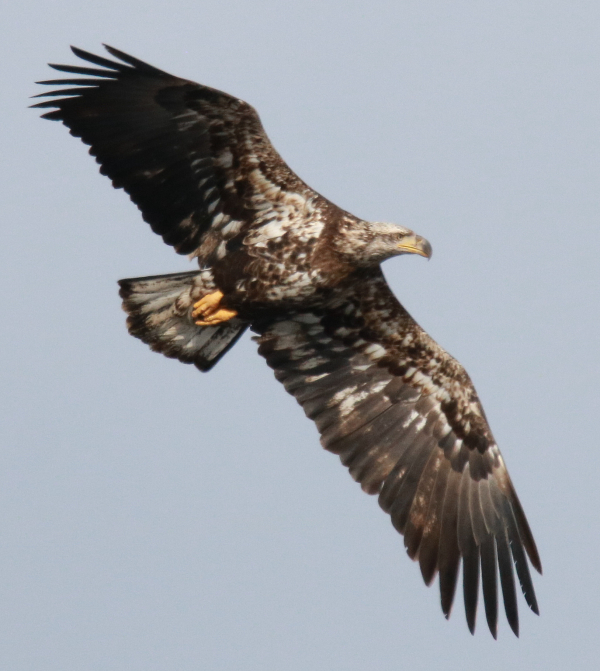
A classic spread-wing photo showing the plumage and colors of a second-year Bald Eagle was used to illustrate the Editor Afield article in this issue.
|
As an editor, a photo editor, and a photographer, when I have a selection of photos to work with it’s often not an easy process to “just pick one.” That becomes especially true when the photos are mine. With a series of 5 or 10 photos before me, which one do I use to illustrate an article – or which ones. This week when I went through that very process, I thought I’d share the effort with the idea that you might gain some insights from my process. I also provided a few of the final photos in the mix, so you can do your own editing of my recent eagle photos.
The idea for this article came to mind after I went through the process of trying to pick out the best photo or photos to illustrate my Editor Afield article in this issue. But let’s start from the beginning, for it was last Thursday when a surprise opportunity to photograph 2 young Bald Eagles flying in tandem presented itself. First the eagles were chasing one another as if in fun, which transition into flushing ducks as a preliminary element to a potential hunt. Quickly though, they began spiraling upward, which provided me with my best opportunities to photograph the impressive young birds. I ended up with a surprisingly nice series of photos of which the best were taken as each of the eagles banked before me just as the sunlight broke through a mostly cloudy sky – now that’s real luck.

This was the author’s favorite photo, which he described as conveying a bit more action, focus, and speed.
|
So often we search for a photo opportunity in good light conditions and hope for the best. In this case the lighting conditions weren’t good, but suddenly, there were the eagles. In response I quickly pulled into a vacant driveway along the edge of the Mississippi River where there was a break in the treeline, hopped out of my vehicle, and there were the eagles, flying low and slow on my side of the river, only 45 yards away. The eagles were almost hovering just above the water on their broad wings with their legs lowered to stabilize their position and help them balance; and one behind the other they flushed a small flock of Common Goldeneyes and scattered Mallards in the process. I photographed the eagles in the midst of this action, but the best photos were yet to come.
With lower light on the cloudy afternoon, I had my camera preset to ISO 800, which would provide brighter images and a faster shutter speed. As I photographed the eagles, I had a chance to quickly check the shutter speed, which was 1/4000, plenty fast enough to stop the speed of most rockets, so I increased the aperture a little to f8 from f7 to ensure I could get the wingtips at both ends of the eagles’ broad wingspan in focus.

Although not a first choice for many people, this photo shows the power invested in the downstroke of this eagle’s wingbeat and the intense focus of its gaze.
|
As the eagles circled higher before me, they flared into the sunlight with their wings fully extended, one after the other, showing their bi-colored plumage indicative of second- and third-year immature Bald Eagles. I took individual photos of the birds in pretty rapid-fire sequence as they banked into the sunlight, and in review I had 5 good photos of the younger “white-belly” eagle, and 3 good photos of the older immature eagle. Now, which ones do I select to illustrate the Editor Afield article?
Back to “Picking One.”
Among the photos before me, I looked at each bird’s images, noting the position of the wings and body, making sure the head was clear of other feathers and body parts behind it, checking for the sharpness of the eyes, beak, and wing tips; noting the lighting and colors, and being aware of the shadows.
But it really wasn’t a matter of just picking out the best photo, or my favorite; it was more about selecting representative photos that illustrated my story, as well as a secondary topic. The 2 immature eagles clearly showed different plumage types indicative of their ages, so by selecting photos of both eagles in similar positions that showed the plumage variations, they would provide what might be a more important visual for readers.

This classic spread-wing photo that shows the plumage and colors of a third-year Bald Eagle was used to illustrate the Editor Afield article in this issue. The lower wing in this photo is shadowed, but it is mostly a mirror image of the other wing that is colored by full sunlight.
|
Thankfully, I had just those kinds of photos among the 5 best images I selected during my photo editing process, and you can see the 2 photos I selected in this issue’s Editor Afield article. But they weren’t my best, or my favorite photos in either case, and that’s an example of picking purpose over preference during my selection process. Yes, the wide-spread wings of the banking eagles show the plumage of each eagle in text book style; and yes, they are dramatic photos regardless of the other photos available. But to be honest, aesthetically, and maybe from the standpoint of a birder, biologist, and photographer, I had other favorites of both the eagles – and that’s part of the reason I wanted to include them in this article – I want to show you my favorites in context with the others.
To show you that, in this article I share the 5 photos I most liked of each eagle – 3 of the younger bird, 2 of the other – all taken within about 15 seconds. My favorite of all of these images is the second photo, which I think shows a bit more action, a bit more focus, a bit more speed. The third photo gives me the impression of strength as the eagle makes a powerful downstroke of its wings, so it might be the most dramatic photo. The last image is not necessarily my favorite but it is actually the sharper version of the 2 images of the third-year eagle, which is always an important consideration when reviewing and editing photos.
 |
Everyone has their own preferences, and I hope you like all the photos, but I also hope that by reviewing these “keepers,” you can imagine how exciting it was to take these photos, to behold these eagles circling in spirited flight, hunting in eagle fashion, and owning the sky they sliced so effortlessly. Photographing them was exhilarating, but at the same time it seemed they transferred a bit of their wild spirit to me, and to the photos. I hope you can see and feel that spirit too, and while we talk a lot about techniques and settings, and lighting, and the activities of the birds before us – it’s the spirit we feel as we photograph the birds, and the spirit we feel when we review inspiring photographs of remarkable birds that really captivates us. Can you feel it?
Article and photographs by Paul Konrad
Share your bird photos and birding experiences at editorstbw2@gmail.com